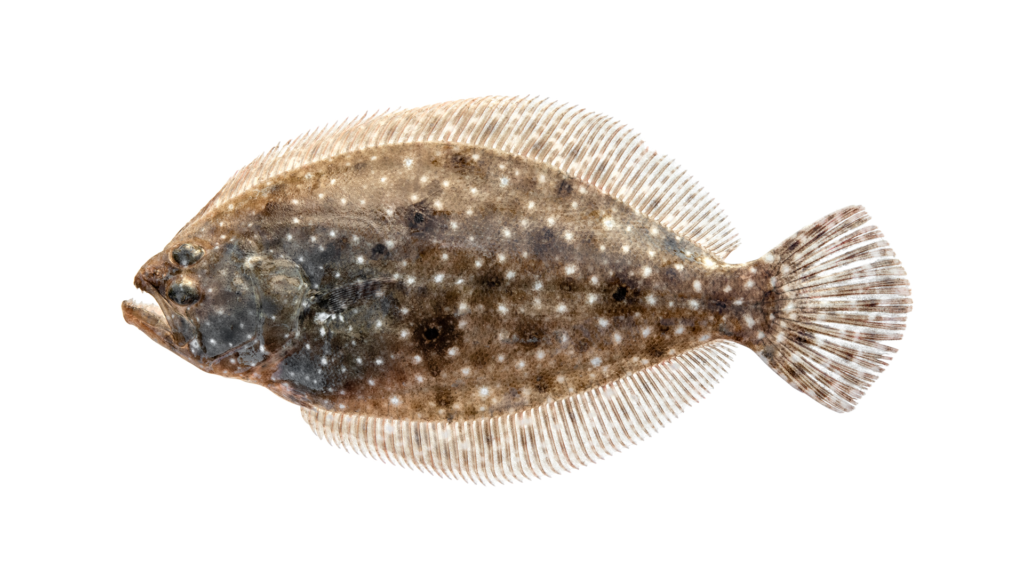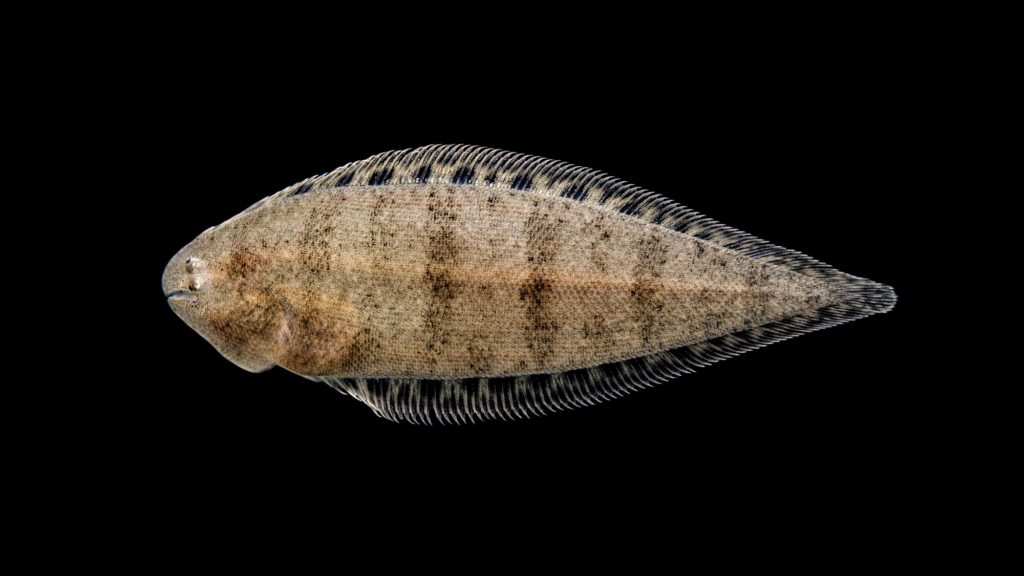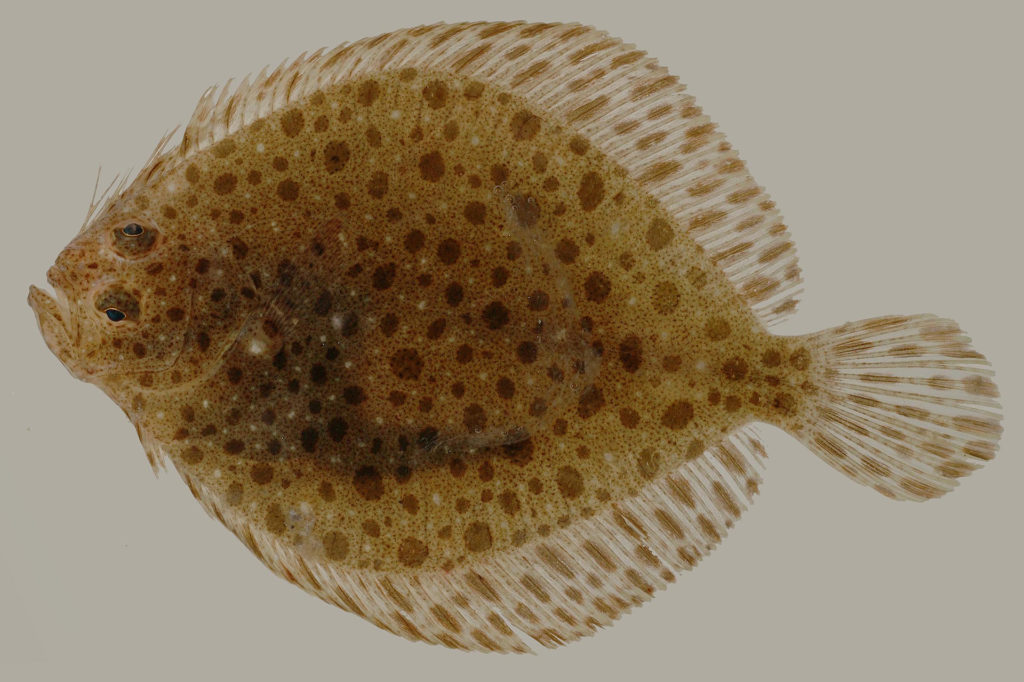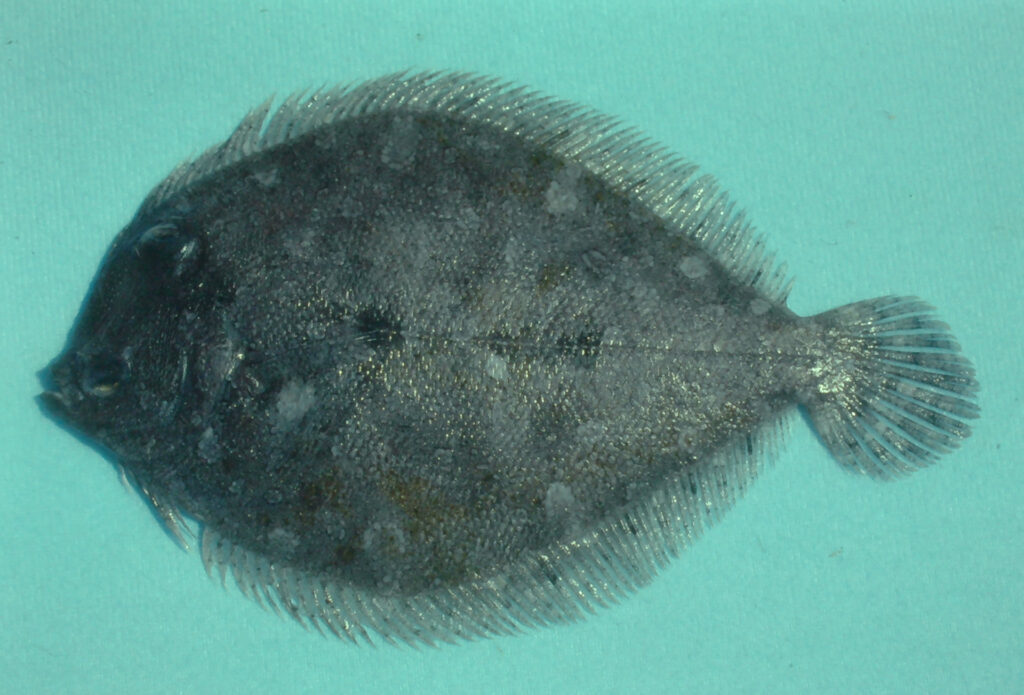By the NCFishes.com Team
Along North Carolina’s shore there are four families of flatfish comprising 36 species having eyes on the left side of their body facing upward when lying in or atop the substrate (NCFishes.com; Table 1; Figure 1). The families and species can be confusing to tell apart. The key characteristics provided for in Table 1 should enable one to differentiate between the four families and this document will aid you in the identification of the species in the Family Paralichthyidae in North Carolina.
Table 1. The four families of left-facing flounders found along and off the coast of North Carolina.| Family | Common Name | Key Characteristics (adapted from Munroe 2002) | No. Species |
|---|---|---|---|
| Paralichthyidae | Sand Flounders | Preopercle exposed, its posterior margin free and visible, not hidden by skin or scales. Dorsal fin long, originating above, lateral to, or anterior to upper eye. Dorsal and anal fins not attached to caudal fin. Both pectoral fins present. Both pelvic fins present, with 5 or 6 rays. | 20 |
| Cynoglossidae | Tonguefishes | Margin of preopercle not free (hidden beneath skin and scales). Pectoral fins absent in adults. Lateral line absent on both sides of body. Dorsal and anal fins joined to caudal fin. No branched caudal-fin rays. | 9 |
| Bothidae | Lefteye Flounders | Lateral line absent or poorly developed on blind side; lateral line absent below lower eye. Lateral line of eyed side with high arch over pectoral fin. Pelvic fin of eyed side on midventral line. | 6 |
| Scophthalmidae | Turbots | Both pelvic fins elongate, placed close to midline and extending forward to urohyal. Pelvic fins free from anal fin, with first ray of blind-side fin opposite second or third ray of eyed-side fin. Lateral line equally developed on both sides of body, with strong arch above pectoral fin, and with distinct supratemporal branch. | 1 |
Figure 1. Examples of left-facing flatfishes found along the coast of North Carolina. From top left clockwise: Paralichthyidae (Gulf Flounder), Cynoglossidae (Blackcheek Tonguefish), Bothidae (Eyed Flounder), and Scophthalmidae (Window Pane). Photograph of Eyed Flounder courtesy of George H. Burgess.
The waters along and off the coast are where you will find 20 species within the Family Paralichthyidae (Table 2) known from North Carolina. (NCFIshes.com; Tracy et al. 2020). [Please note: Tracy et al. (2020) may be downloaded for free at: https://trace.tennessee.edu/sfcproceedings/vol1/iss60/1.] You may also encounter Southern Flounder as a seasonal inhabitant in freshwater habitats along the coast from the Shallotte to the Albemarle basins (Tracy et al. 2020). [Note: see Supplemental Maps 1-3, page 26, showing North Carolina’s 100 counties, 21 river basins, and 4 physiographic regions.]
Table 2. Species of Sand Flounders found in or along the coast of North Carolina.| Scientific Name/ American Fisheries Society Accepted Common Name | Scientific Name/ American Fisheries Society Accepted Common Name |
|---|---|
| Ancylopsetta dilecta – Three-eye Flounder | Etropus microstomus – Smallmouth Flounder |
| Ancylopsetta quadrocellata – Ocellated Flounder | Etropus rimosus – Gray Flounder |
| Citharichthys arctifrons – Gulf Stream Flounder | Gastropsetta frontalis – Shrimp Flounder |
| Citharichthys cornutus – Horned Whiff | Paralichthys albigutta – Gulf Flounder |
| Citharichthys gymnorhinus – Anglefin Whiff | Paralichthys dentatus – Summer Flounder |
| Citharichthys macrops – Spotted Whiff | Paralichthys lethostigma – Southern Flounder |
| Citharichthys spilopterus – Bay Whiff | Paralichthys oblongus – Fourspot Flounder |
| Cyclopsetta fimbriata – Spotfin Flounder | Paralichthys squamilentus – Broad Flounder |
| Etropus crossotus – Fringed Flounder | Syacium micrurum – Channel Flounder |
| Etropus cyclosquamus – Shelf Flounder | Syacium papillosum – Dusky Flounder |
Unlike many families of fishes found in North Carolina’s waters, the Family Paralichthyidae is known only by a handful of local or vernacular names such as flounder, mud flounder, Plaice, sand flounder, Summer Flounder, and fluke. Often, any flatfish is simply called a flounder, regardless of its species or to which family it belongs. However there are American Fisheries Society-accepted common names (Table 2; Page et al. 2013) and each of the scientific (Latin) names actually means something (please refer to The Meanings of the Scientific Names of Sand Flounders, pages 24-25).
In 1585-1593, John White illustrated what is possibly Broad Flounder (or one of the other species of Paralichthys) labeled with the Algonquin word used by the Croatoan First Peoples,Pashockshin (https://www.coastalcarolinaindians.com/updated-algonquian-word-list-by-scott-dawson/), and noted: “The Playse. A foote and a halfe in length” (Figure 2).

Figure 2. Possibly Broad Flounder by John White, 1585-1593. Painting courtesy of the British Museum, Museum No. SL,5270.97 (https://www.britishmuseum.org/collection/object/P_SL-5270-97).
More than a century after John White painted this fish, flounder was mentioned as occurring in North Carolina’s waters by John Lawson in 1709 who described flounder as: “Plaice are here very large, and plentiful, being the same as in England” and “Flounders should have gone amongst the Fresh-Water Fish, because they are caught there, in great Plenty” (Lawson (1709), p.156-157). Perhaps, Lawson was referring to Southern Flounder which are often found far upstream in coastal rivers in fresh water. To this day, the larger species such as Summer Flounder and Southern Flounder are commercially and recreationally important species that continue to be sought after for delicious table food fare (Manooch 1984).
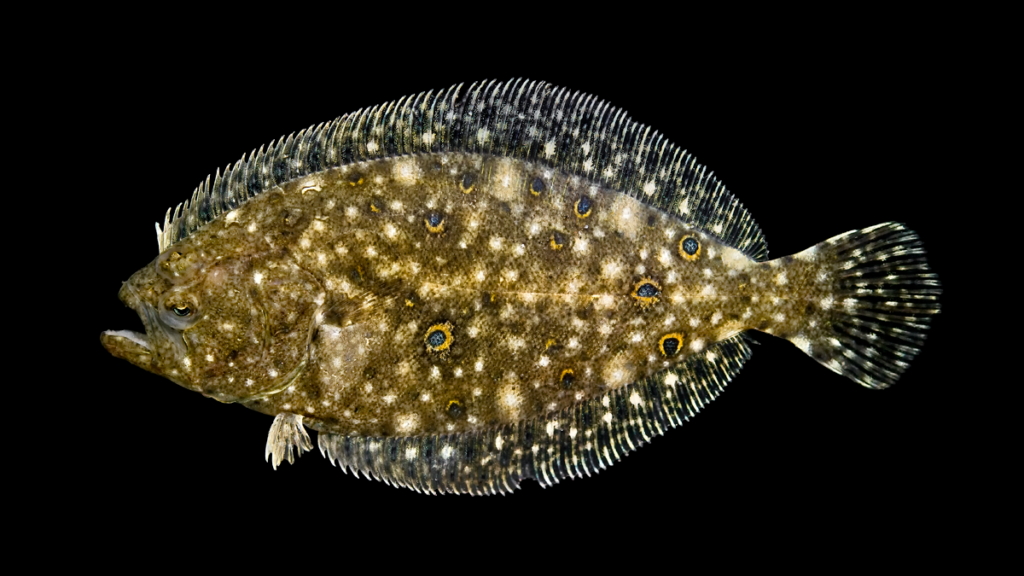
Our sand flounders vary substantially in size from the petite 76 mm (3 inches) Anglefin Whiff to the “doormat-sized” Summer Flounder which can reach 914 mm (36 inches). The smaller species, less than about 200 mm (8 inches), include Citharichthys spp., and Etropus spp. Larger species, more than 610 mm (24 inches) include Paralichthys spp.
Sand flounders are demersal fish meaning they live on or buried beneath the bottom substrates. These bottoms can be hard or soft sand, coarse shelly debris, or mud in lower coastal river channels and estuaries, inlets, and in seagrass beds. They often bury themselves into the sediment as they wait to ambush their prey. Like their size, depths to where they may be found also vary considerably. Many species are found in shallow waters along the shore, but some like Three-eye Flounder, Gulf Stream Flounder, Horned Whiff, and Channel Flounder may be found as deep as 1200-1300 feet near the edge of the Continental Shelf (Kells and Carpenter 2014).
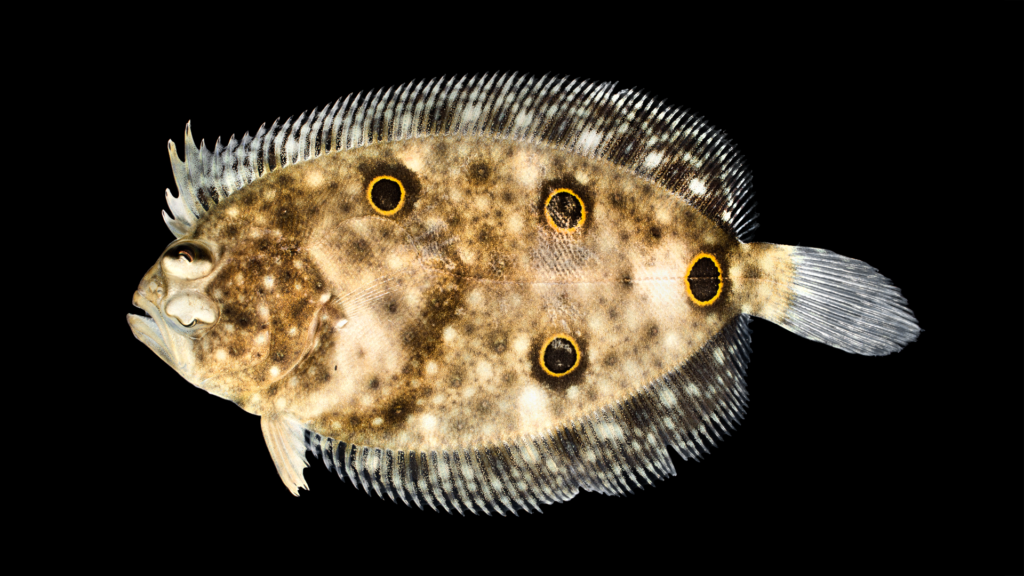
Except for Southern Flounder, all sand flounders are found exclusively in coastal waters (Maps 1-14). However, some of the species’ mapped distributions may be an artifact of their rarity as vouchered specimens at North Carolina Museum of Natural Sciences (i.e., researchers being hesitant to preserve large-bodied specimens or recreationally important game species) and/or their rarity in North Carolina waters. Distributional maps, based upon vouchered specimens at the North Carolina Museum of Natural Sciences, are unavailable for Shelf Flounder, Shrimp Flounder, and Channel Flounder.
Southern Flounder also venture into fresh water – quite the upstream distance from their normal marine environments (Map 12). They have been found in the Cape Fear River upstream near Lock and Dam No. 1 (Cape Fear basin), in the Neuse River as far upstream as near the Town of LaGrange (Neuse basin), in the Roanoke River as far upstream as at the Town of Weldon (Roanoke basin), and in the Chowan River as far upstream as at Arrowhead Beach (Chowan basin) (Tracy et al. 2020).
None of the species is a federally- or state-listed species (NCAC 2017; NCNHP 2020; NCWRC 2017). The recreational and commercial harvesting (take) of some species of flounder are state regulated by the North Carolina Division of Marine Fisheries and the North Carolina Wildlife Resources Commission (NCDMF 2020; NCWRC 2020).
The identification of sand flounder can be challenging. Complicating that fact is that specimens captured inshore or offshore using a trawl are often “ragged looking” because of fin damage and scale loss during the collection process. Critical scale pigmentation patterns may be rendered impractical because all that remain are the scale pockets. If the specimen does not look like it has been “rung through the wringer” key characteristics for its proper identification include the shape of the lateral line; the length of the anterior dorsal fin rays; the origin of the dorsal fin; the presence or absence of pigmented spots (ocelli) and their placement; dorsal and anal fin and gill raker counts; size of mouth; body depth in relation to Standard Length; and the presence or absence of ctenoid scales (please refer to the Identification Key to the Sand Flounders (Family Paralichthyidae) in North Carolina).
If you have troubles with your identifications, just send us (https://ncfishes.com/contact/) an e-mail and include as many quality digital photographs as you can along with all the pertinent locality descriptors so that we will know from where the fish came.
